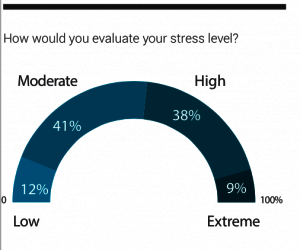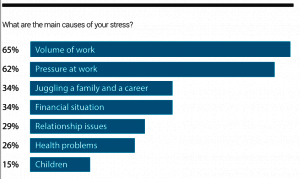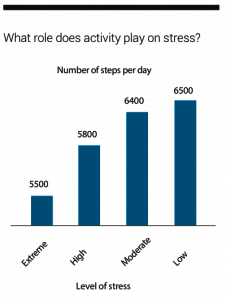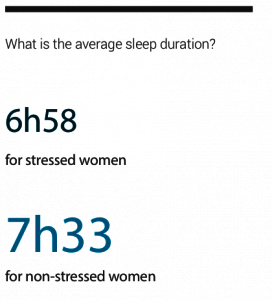
A woman’s life is rarely easy. Between work and family, there are several possible sources of stress. To understand and develop solutions to manage stress, we conducted an in-depth study with approximately 3,400 women who use Withings products. Read on for the exciting conclusions, and some potentially calming solutions.
Earlier this year, we conducted a study on Wellness in the Workplace to determine correlations between work environments and overall health and happiness levels. According to the study, 45% of women reported that they were stressed, as opposed to 36% of men who reported feeling stressed. We decided to dive deeper into the topic to try and understand why women are so stressed so that we would then be able to offer solutions that could help manage a stressful lifestyle.
We often hear the phrases, “What doesn’t kill you makes you stronger” and “a little stress never hurt anyone.” From these sentiments, many people develop the idea that stress is a sign of mental weakness. By this accord, admitting to feelings of stress means admitting personal failure, a potential lack of competence in the workplace, or a general inability to deal with life’s challenges. Stress, much like depression, is a serious yet common issue that should be acknowledged head on and not belittled or made shameful. The first step to combatting stress is understanding its source.
47% of women are living a stressful life

Only 12% of women reported low stress levels, while the remaining 88% of respondents experience moderate to extreme levels of stress. More alarming is that 47% of women are experiencing high or extreme levels of stress on a regular basis.
54% of women have felt completely burnt out

Much to our surprise, over 50% of women have already experienced a severe enough period of stress to classify themselves as “burnt out.” This demonstrates that the concept of burn out is much more prevalent, and dangerous, than we thought. Even with these staggeringly high numbers, few people speak openly and unabashedly about their stress levels. Society might not be generally accepting when people complain about stress levels or personal issues, which makes it more difficult to recognize the true severity and frequency with which stress occurs.
Work is the number one source of stress

Unsurprisingly, the study shows that work, the place where we often spend most of our waking hours (and energy) is the main source of stress. Work related stress (volume and pressure) is nearly double the second highest form of stress — juggling a family and a career. Even financial stresses do not come close to the pressures felt in the workplace.
Activity is the number one way to combat stress

With only 24 hours in a day and a million things to do, it is not all that surprising that people feel elevated levels of stress. The question is: What are women doing about it? The number one reported solution for managing high stress levels was physical activity. People turned to the gym, the track, or their yoga mats to help alleviate some of the physical tension their bodies experience. Beyond exercise, the most common stress management techniques are taking days off from work and stress eating. Eating a pint of Ben and Jerry’s after a bad breakup may be a rom-com trope, but the overconsumption of food during stressful experiences is a highly common issue. In fact, not only does overeating take a toll on health, it often leads back to feelings of guilt or regret, further fueling the cycle of stress.
Increasing physical activity on the other hand, is an extremely healthy and, according to this study, much more successful way of combatting stress.
Active women are less stressed

We see a direct correlation between higher levels of activity and lower reported stress levels. Women who were less stressed walked an average of 1,000 more steps per day than those who classified their stress level as extreme. Using physical activity as a way to manage stress has the upside of positive effects on overall health.
Stress is bad for the heart

We notice that people who have lower reported stress levels appear to be in better cardiovascular health. The average resting heart rate for low stress levels is 5% lower than those who reported high or extreme levels of stress. Want to know more? Here’s a quick read on how to measure heart rate and find out what it means.
Women who aren’t stressed sleep better

The study also revealed that stress can take a toll on sleep duration and quality. Women who were less stressed slept an average of 35 minutes more per night. Getting the sleep your body needs has tremendous effects not only on the general level of exhaustion throughout the day, but is vital to many body processes. The heart, for instance, uses time asleep to beat more slowly and restore itself for the next day. For more on this see: Heart Health And Sleep. Similarly, sleep is imperative for the brain for the process of memory restoration and recollection.
So what can you do with all this information?
MOVE! Whether you’re a runner, a yogi, a power walker, a dog walker, or a retired athlete, make sure to listen to your body and strive for at least 10,000 steps a day to keep your stress levels under control.
Did you know?
According to the Withings Health Observatory, people who use activity trackers walk an average of 20% more than those who don’t. So, if you need one, ah yes, we have some suggestions:
Which tracker is right for you?
About the data:
This study was constructed based on self reported responses and measurement data from Withings connected objects , from a sample of 3400 working women in the United States, France and Germany.
Withings guarantees the confidentiality of personal data and protects the privacy of all users. Thus, all data used for this study was anonymized and aggregated in order to prevent re-identification . Participants provided their consent to the data that was used in this study.


